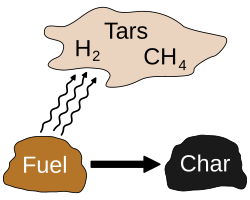
Torrefaction of biomass, e.g., wood or grain, is a mild form of pyrolysis at temperatures typically between 200 and 320 °C. Torrefaction changes biomass properties to provide a better fuel quality for combustion and gasification applications. Torrefaction produces a relatively dry product, which reduces or eliminates its potential for organic decomposition. Torrefaction combined with densification creates an energy-dense fuel carrier of 20 to 21 GJ/ton lower heating value (LHV).[1] Torrefaction causes the material to undergo Maillard reactions. Torrefied biomass can be used as an energy carrier or as a feedstock used in the production of bio-based fuels and chemicals.[2]
Biomass can be an important energy source.[3] However, there exists a large diversity of potential biomass sources, each with its own unique characteristics. To create efficient biomass-to-energy chains, torrefaction of biomass, combined with densification (pelletisation or briquetting), is a promising step towards overcoming the logistical challenges in developing large-scale sustainable energy solutions, by making it easier to transport and store. Pellets or briquettes have higher density, contain less moisture, and are more stable in storage than the biomass they are derived from.
- ^ Austin, Anna (April 20, 2010). "French torrefaction firm targets North America". Biomass Power and Thermal. Retrieved February 29, 2012.
- ^ Koukoulas, A.A. (2016). "Torrefaction: A Pathway Towards Fungible Biomass Feedstocks?" (PDF). Advanced Bioeconomy Feedstocks Conference.
- ^ Johnson, Robin (2007). "Torrefaction - A Warmer Solution to a Colder Climate". World Conservation and Wildlife Trust. Archived from the original on October 2, 2013. Retrieved September 30, 2013.